Project Management Plan: Analysis of Three Engineering Projects
VerifiedAdded on 2021/06/18
|30
|9134
|164
Project
AI Summary
This project management plan analyzes three engineering projects (A, B, and C), focusing on their key characteristics, strategic alignment, and potential risks. Project A involves developing a new asset management information system, highlighting stakeholder management challenges and the importance of effective communication. Project B centers on facility development in remote areas, addressing delays, financial risks, and the need for better integration. Project C concerns infrastructure development, emphasizing stakeholder management, environmental considerations, and the impact of potential citizen action. The plan includes reviews of each project, proposes solutions, and integrates elements like milestone tables and a Gantt chart to visualize project timelines and dependencies. The report concludes with an essay discussing project management concepts and challenges.
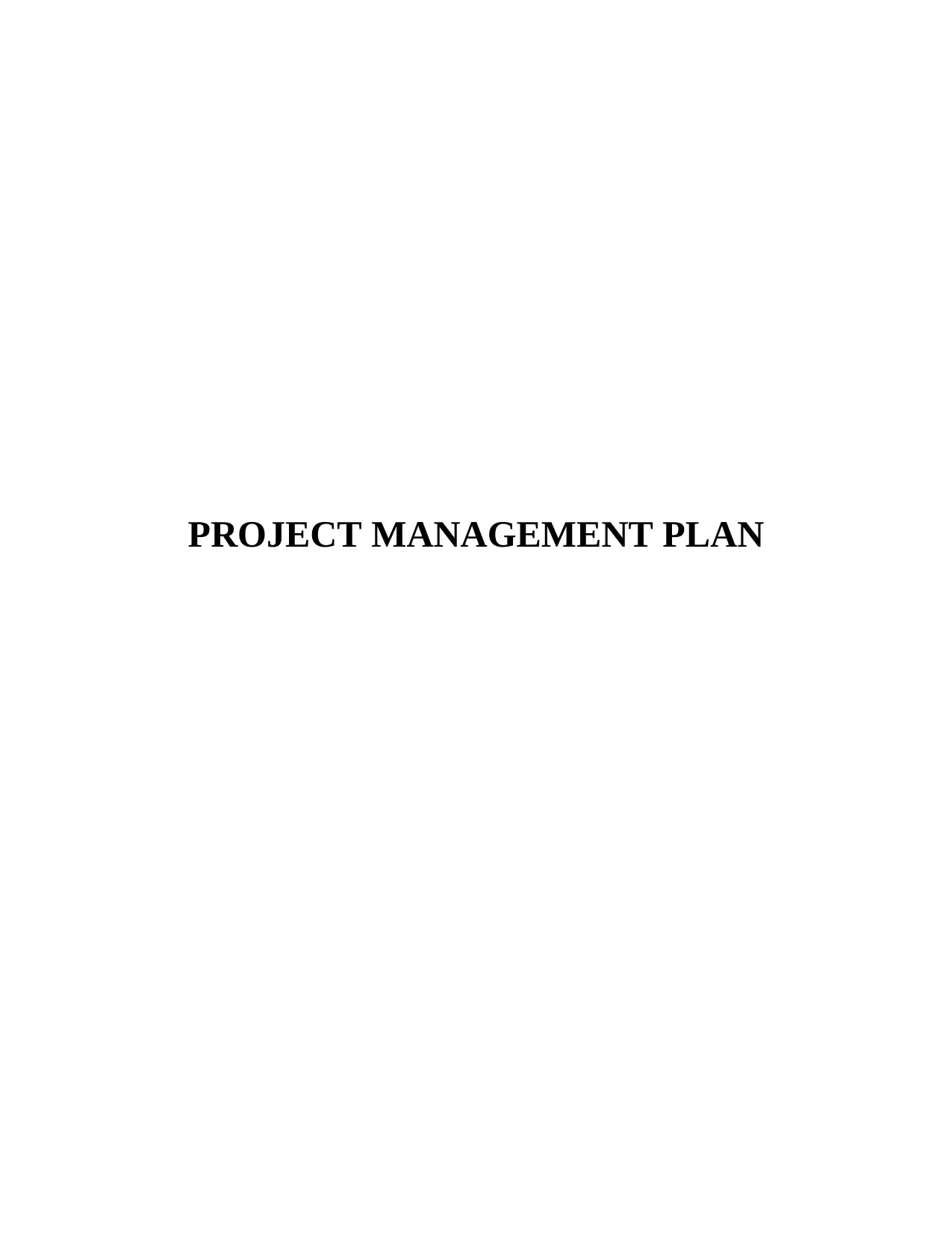
PROJECT MANAGEMENT PLAN
Paraphrase This Document
Need a fresh take? Get an instant paraphrase of this document with our AI Paraphraser
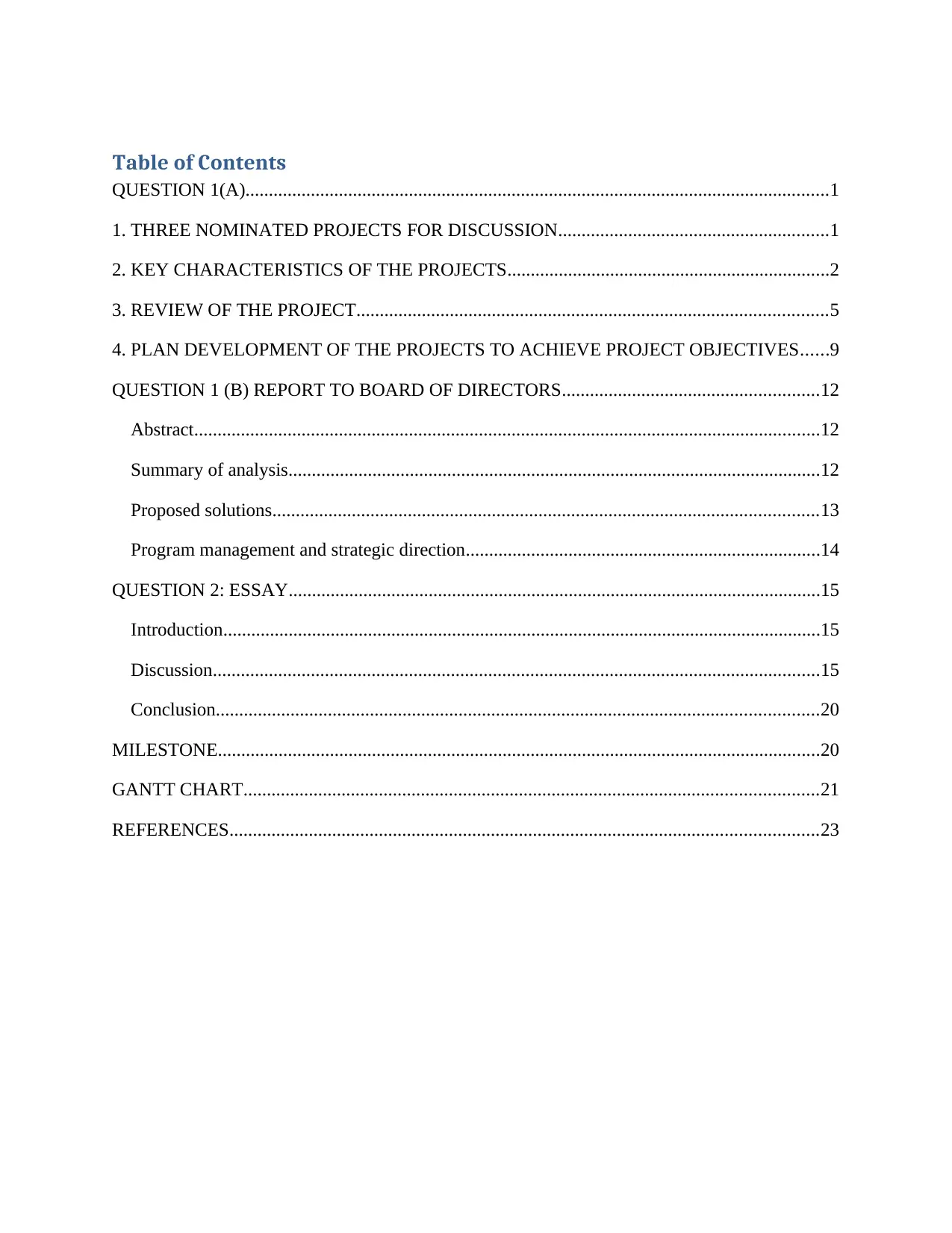
Table of Contents
QUESTION 1(A).............................................................................................................................1
1. THREE NOMINATED PROJECTS FOR DISCUSSION..........................................................1
2. KEY CHARACTERISTICS OF THE PROJECTS.....................................................................2
3. REVIEW OF THE PROJECT.....................................................................................................5
4. PLAN DEVELOPMENT OF THE PROJECTS TO ACHIEVE PROJECT OBJECTIVES......9
QUESTION 1 (B) REPORT TO BOARD OF DIRECTORS.......................................................12
Abstract......................................................................................................................................12
Summary of analysis..................................................................................................................12
Proposed solutions.....................................................................................................................13
Program management and strategic direction............................................................................14
QUESTION 2: ESSAY..................................................................................................................15
Introduction................................................................................................................................15
Discussion..................................................................................................................................15
Conclusion.................................................................................................................................20
MILESTONE.................................................................................................................................20
GANTT CHART...........................................................................................................................21
REFERENCES..............................................................................................................................23
QUESTION 1(A).............................................................................................................................1
1. THREE NOMINATED PROJECTS FOR DISCUSSION..........................................................1
2. KEY CHARACTERISTICS OF THE PROJECTS.....................................................................2
3. REVIEW OF THE PROJECT.....................................................................................................5
4. PLAN DEVELOPMENT OF THE PROJECTS TO ACHIEVE PROJECT OBJECTIVES......9
QUESTION 1 (B) REPORT TO BOARD OF DIRECTORS.......................................................12
Abstract......................................................................................................................................12
Summary of analysis..................................................................................................................12
Proposed solutions.....................................................................................................................13
Program management and strategic direction............................................................................14
QUESTION 2: ESSAY..................................................................................................................15
Introduction................................................................................................................................15
Discussion..................................................................................................................................15
Conclusion.................................................................................................................................20
MILESTONE.................................................................................................................................20
GANTT CHART...........................................................................................................................21
REFERENCES..............................................................................................................................23

List of figures
Figure 1: Gantt chart......................................................................................................................22
Figure 1: Gantt chart......................................................................................................................22
⊘ This is a preview!⊘
Do you want full access?
Subscribe today to unlock all pages.

Trusted by 1+ million students worldwide

List of table
Table 1: Milestone table................................................................................................................20
Table 1: Milestone table................................................................................................................20
Paraphrase This Document
Need a fresh take? Get an instant paraphrase of this document with our AI Paraphraser
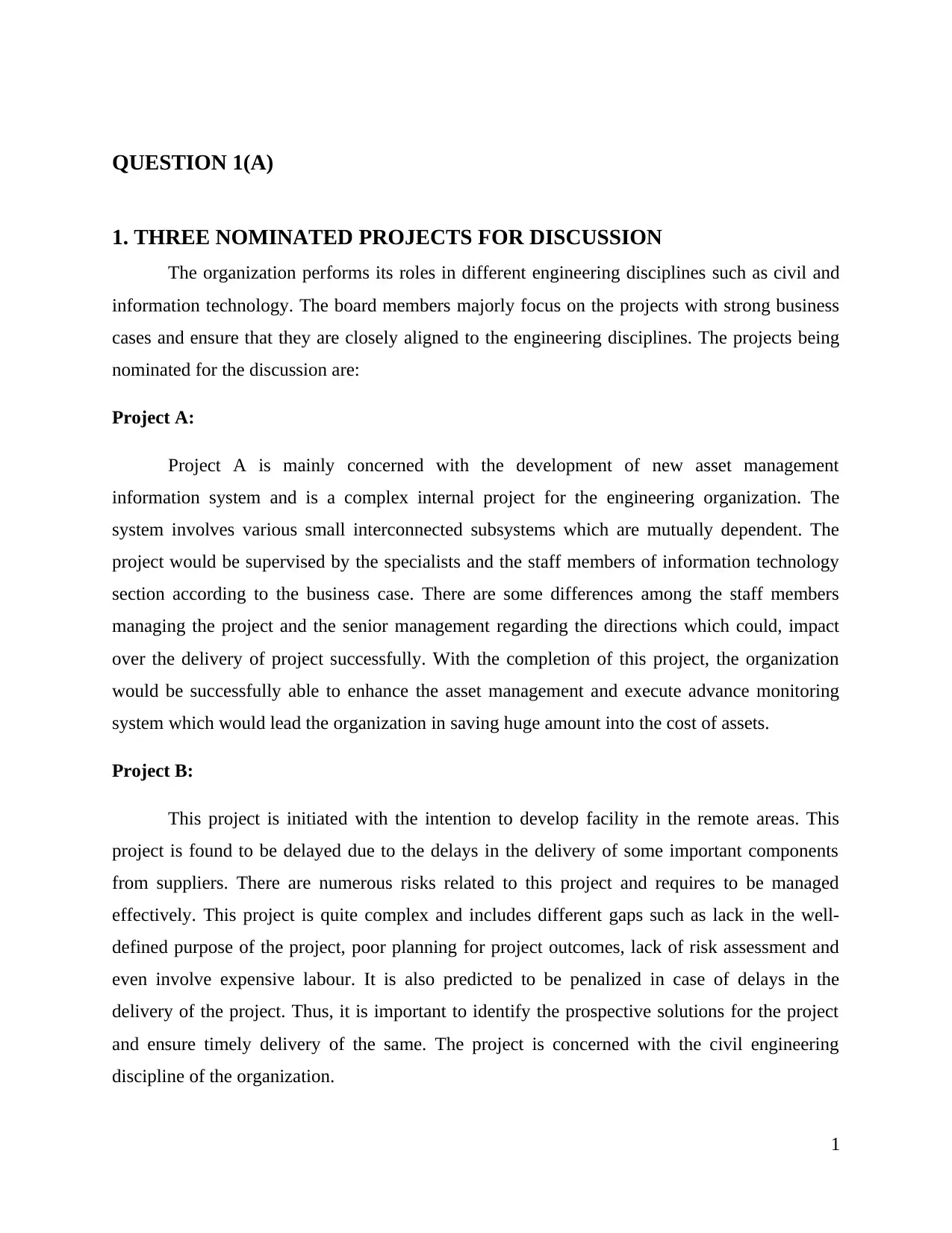
QUESTION 1(A)
1. THREE NOMINATED PROJECTS FOR DISCUSSION
The organization performs its roles in different engineering disciplines such as civil and
information technology. The board members majorly focus on the projects with strong business
cases and ensure that they are closely aligned to the engineering disciplines. The projects being
nominated for the discussion are:
Project A:
Project A is mainly concerned with the development of new asset management
information system and is a complex internal project for the engineering organization. The
system involves various small interconnected subsystems which are mutually dependent. The
project would be supervised by the specialists and the staff members of information technology
section according to the business case. There are some differences among the staff members
managing the project and the senior management regarding the directions which could, impact
over the delivery of project successfully. With the completion of this project, the organization
would be successfully able to enhance the asset management and execute advance monitoring
system which would lead the organization in saving huge amount into the cost of assets.
Project B:
This project is initiated with the intention to develop facility in the remote areas. This
project is found to be delayed due to the delays in the delivery of some important components
from suppliers. There are numerous risks related to this project and requires to be managed
effectively. This project is quite complex and includes different gaps such as lack in the well-
defined purpose of the project, poor planning for project outcomes, lack of risk assessment and
even involve expensive labour. It is also predicted to be penalized in case of delays in the
delivery of the project. Thus, it is important to identify the prospective solutions for the project
and ensure timely delivery of the same. The project is concerned with the civil engineering
discipline of the organization.
1
1. THREE NOMINATED PROJECTS FOR DISCUSSION
The organization performs its roles in different engineering disciplines such as civil and
information technology. The board members majorly focus on the projects with strong business
cases and ensure that they are closely aligned to the engineering disciplines. The projects being
nominated for the discussion are:
Project A:
Project A is mainly concerned with the development of new asset management
information system and is a complex internal project for the engineering organization. The
system involves various small interconnected subsystems which are mutually dependent. The
project would be supervised by the specialists and the staff members of information technology
section according to the business case. There are some differences among the staff members
managing the project and the senior management regarding the directions which could, impact
over the delivery of project successfully. With the completion of this project, the organization
would be successfully able to enhance the asset management and execute advance monitoring
system which would lead the organization in saving huge amount into the cost of assets.
Project B:
This project is initiated with the intention to develop facility in the remote areas. This
project is found to be delayed due to the delays in the delivery of some important components
from suppliers. There are numerous risks related to this project and requires to be managed
effectively. This project is quite complex and includes different gaps such as lack in the well-
defined purpose of the project, poor planning for project outcomes, lack of risk assessment and
even involve expensive labour. It is also predicted to be penalized in case of delays in the
delivery of the project. Thus, it is important to identify the prospective solutions for the project
and ensure timely delivery of the same. The project is concerned with the civil engineering
discipline of the organization.
1
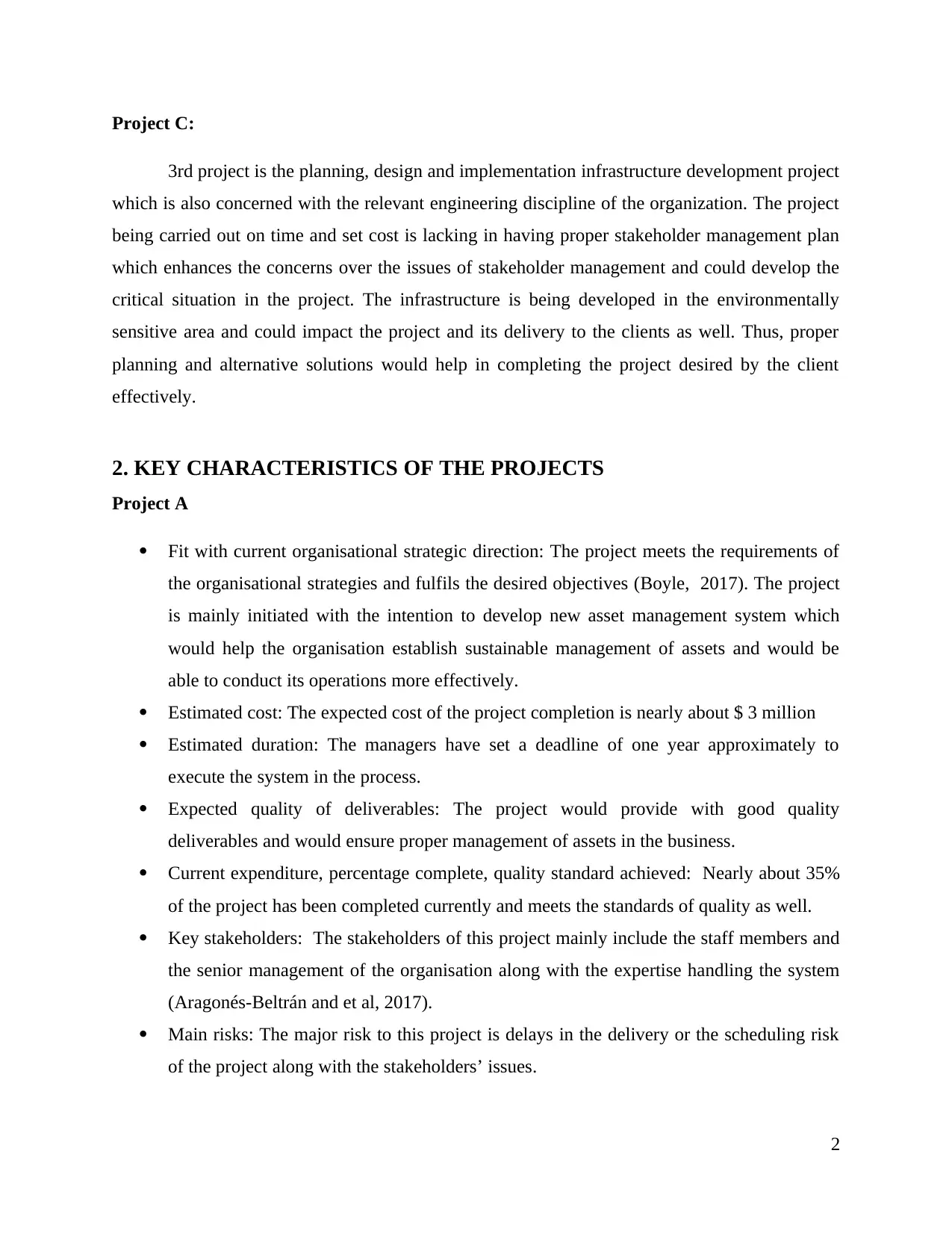
Project C:
3rd project is the planning, design and implementation infrastructure development project
which is also concerned with the relevant engineering discipline of the organization. The project
being carried out on time and set cost is lacking in having proper stakeholder management plan
which enhances the concerns over the issues of stakeholder management and could develop the
critical situation in the project. The infrastructure is being developed in the environmentally
sensitive area and could impact the project and its delivery to the clients as well. Thus, proper
planning and alternative solutions would help in completing the project desired by the client
effectively.
2. KEY CHARACTERISTICS OF THE PROJECTS
Project A
Fit with current organisational strategic direction: The project meets the requirements of
the organisational strategies and fulfils the desired objectives (Boyle, 2017). The project
is mainly initiated with the intention to develop new asset management system which
would help the organisation establish sustainable management of assets and would be
able to conduct its operations more effectively.
Estimated cost: The expected cost of the project completion is nearly about $ 3 million
Estimated duration: The managers have set a deadline of one year approximately to
execute the system in the process.
Expected quality of deliverables: The project would provide with good quality
deliverables and would ensure proper management of assets in the business.
Current expenditure, percentage complete, quality standard achieved: Nearly about 35%
of the project has been completed currently and meets the standards of quality as well.
Key stakeholders: The stakeholders of this project mainly include the staff members and
the senior management of the organisation along with the expertise handling the system
(Aragonés-Beltrán and et al, 2017).
Main risks: The major risk to this project is delays in the delivery or the scheduling risk
of the project along with the stakeholders’ issues.
2
3rd project is the planning, design and implementation infrastructure development project
which is also concerned with the relevant engineering discipline of the organization. The project
being carried out on time and set cost is lacking in having proper stakeholder management plan
which enhances the concerns over the issues of stakeholder management and could develop the
critical situation in the project. The infrastructure is being developed in the environmentally
sensitive area and could impact the project and its delivery to the clients as well. Thus, proper
planning and alternative solutions would help in completing the project desired by the client
effectively.
2. KEY CHARACTERISTICS OF THE PROJECTS
Project A
Fit with current organisational strategic direction: The project meets the requirements of
the organisational strategies and fulfils the desired objectives (Boyle, 2017). The project
is mainly initiated with the intention to develop new asset management system which
would help the organisation establish sustainable management of assets and would be
able to conduct its operations more effectively.
Estimated cost: The expected cost of the project completion is nearly about $ 3 million
Estimated duration: The managers have set a deadline of one year approximately to
execute the system in the process.
Expected quality of deliverables: The project would provide with good quality
deliverables and would ensure proper management of assets in the business.
Current expenditure, percentage complete, quality standard achieved: Nearly about 35%
of the project has been completed currently and meets the standards of quality as well.
Key stakeholders: The stakeholders of this project mainly include the staff members and
the senior management of the organisation along with the expertise handling the system
(Aragonés-Beltrán and et al, 2017).
Main risks: The major risk to this project is delays in the delivery or the scheduling risk
of the project along with the stakeholders’ issues.
2
⊘ This is a preview!⊘
Do you want full access?
Subscribe today to unlock all pages.

Trusted by 1+ million students worldwide
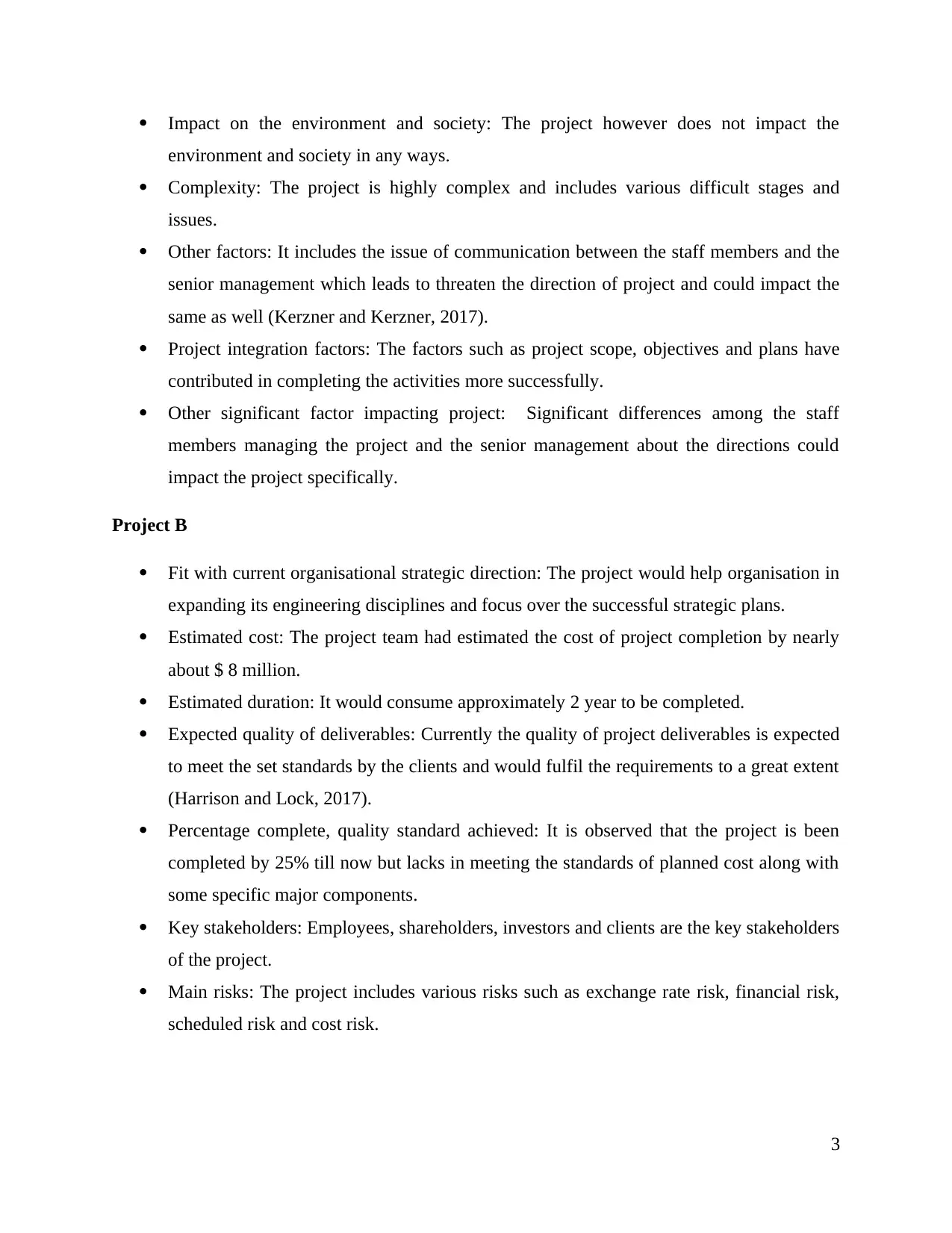
Impact on the environment and society: The project however does not impact the
environment and society in any ways.
Complexity: The project is highly complex and includes various difficult stages and
issues.
Other factors: It includes the issue of communication between the staff members and the
senior management which leads to threaten the direction of project and could impact the
same as well (Kerzner and Kerzner, 2017).
Project integration factors: The factors such as project scope, objectives and plans have
contributed in completing the activities more successfully.
Other significant factor impacting project: Significant differences among the staff
members managing the project and the senior management about the directions could
impact the project specifically.
Project B
Fit with current organisational strategic direction: The project would help organisation in
expanding its engineering disciplines and focus over the successful strategic plans.
Estimated cost: The project team had estimated the cost of project completion by nearly
about $ 8 million.
Estimated duration: It would consume approximately 2 year to be completed.
Expected quality of deliverables: Currently the quality of project deliverables is expected
to meet the set standards by the clients and would fulfil the requirements to a great extent
(Harrison and Lock, 2017).
Percentage complete, quality standard achieved: It is observed that the project is been
completed by 25% till now but lacks in meeting the standards of planned cost along with
some specific major components.
Key stakeholders: Employees, shareholders, investors and clients are the key stakeholders
of the project.
Main risks: The project includes various risks such as exchange rate risk, financial risk,
scheduled risk and cost risk.
3
environment and society in any ways.
Complexity: The project is highly complex and includes various difficult stages and
issues.
Other factors: It includes the issue of communication between the staff members and the
senior management which leads to threaten the direction of project and could impact the
same as well (Kerzner and Kerzner, 2017).
Project integration factors: The factors such as project scope, objectives and plans have
contributed in completing the activities more successfully.
Other significant factor impacting project: Significant differences among the staff
members managing the project and the senior management about the directions could
impact the project specifically.
Project B
Fit with current organisational strategic direction: The project would help organisation in
expanding its engineering disciplines and focus over the successful strategic plans.
Estimated cost: The project team had estimated the cost of project completion by nearly
about $ 8 million.
Estimated duration: It would consume approximately 2 year to be completed.
Expected quality of deliverables: Currently the quality of project deliverables is expected
to meet the set standards by the clients and would fulfil the requirements to a great extent
(Harrison and Lock, 2017).
Percentage complete, quality standard achieved: It is observed that the project is been
completed by 25% till now but lacks in meeting the standards of planned cost along with
some specific major components.
Key stakeholders: Employees, shareholders, investors and clients are the key stakeholders
of the project.
Main risks: The project includes various risks such as exchange rate risk, financial risk,
scheduled risk and cost risk.
3
Paraphrase This Document
Need a fresh take? Get an instant paraphrase of this document with our AI Paraphraser
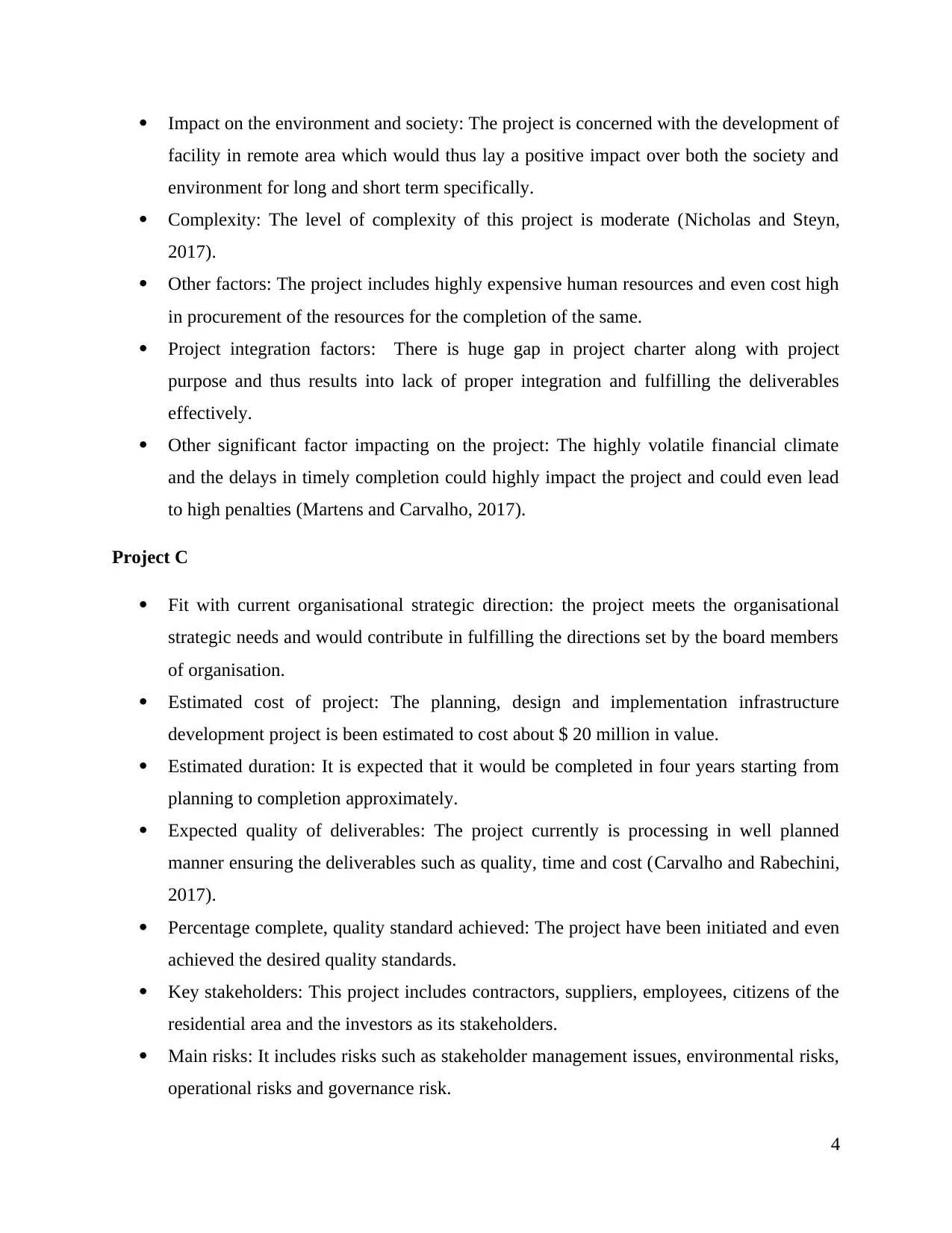
Impact on the environment and society: The project is concerned with the development of
facility in remote area which would thus lay a positive impact over both the society and
environment for long and short term specifically.
Complexity: The level of complexity of this project is moderate (Nicholas and Steyn,
2017).
Other factors: The project includes highly expensive human resources and even cost high
in procurement of the resources for the completion of the same.
Project integration factors: There is huge gap in project charter along with project
purpose and thus results into lack of proper integration and fulfilling the deliverables
effectively.
Other significant factor impacting on the project: The highly volatile financial climate
and the delays in timely completion could highly impact the project and could even lead
to high penalties (Martens and Carvalho, 2017).
Project C
Fit with current organisational strategic direction: the project meets the organisational
strategic needs and would contribute in fulfilling the directions set by the board members
of organisation.
Estimated cost of project: The planning, design and implementation infrastructure
development project is been estimated to cost about $ 20 million in value.
Estimated duration: It is expected that it would be completed in four years starting from
planning to completion approximately.
Expected quality of deliverables: The project currently is processing in well planned
manner ensuring the deliverables such as quality, time and cost (Carvalho and Rabechini,
2017).
Percentage complete, quality standard achieved: The project have been initiated and even
achieved the desired quality standards.
Key stakeholders: This project includes contractors, suppliers, employees, citizens of the
residential area and the investors as its stakeholders.
Main risks: It includes risks such as stakeholder management issues, environmental risks,
operational risks and governance risk.
4
facility in remote area which would thus lay a positive impact over both the society and
environment for long and short term specifically.
Complexity: The level of complexity of this project is moderate (Nicholas and Steyn,
2017).
Other factors: The project includes highly expensive human resources and even cost high
in procurement of the resources for the completion of the same.
Project integration factors: There is huge gap in project charter along with project
purpose and thus results into lack of proper integration and fulfilling the deliverables
effectively.
Other significant factor impacting on the project: The highly volatile financial climate
and the delays in timely completion could highly impact the project and could even lead
to high penalties (Martens and Carvalho, 2017).
Project C
Fit with current organisational strategic direction: the project meets the organisational
strategic needs and would contribute in fulfilling the directions set by the board members
of organisation.
Estimated cost of project: The planning, design and implementation infrastructure
development project is been estimated to cost about $ 20 million in value.
Estimated duration: It is expected that it would be completed in four years starting from
planning to completion approximately.
Expected quality of deliverables: The project currently is processing in well planned
manner ensuring the deliverables such as quality, time and cost (Carvalho and Rabechini,
2017).
Percentage complete, quality standard achieved: The project have been initiated and even
achieved the desired quality standards.
Key stakeholders: This project includes contractors, suppliers, employees, citizens of the
residential area and the investors as its stakeholders.
Main risks: It includes risks such as stakeholder management issues, environmental risks,
operational risks and governance risk.
4
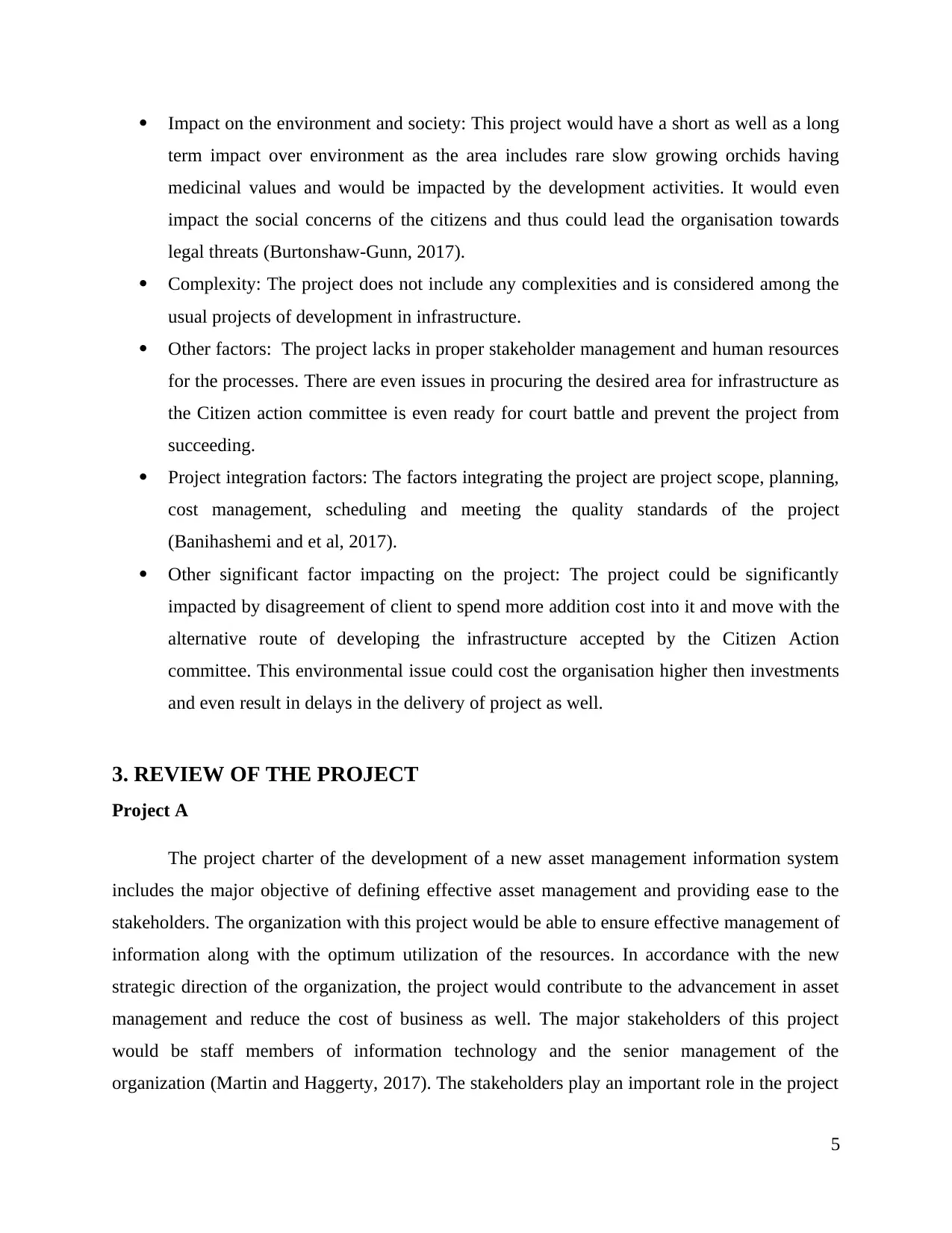
Impact on the environment and society: This project would have a short as well as a long
term impact over environment as the area includes rare slow growing orchids having
medicinal values and would be impacted by the development activities. It would even
impact the social concerns of the citizens and thus could lead the organisation towards
legal threats (Burtonshaw-Gunn, 2017).
Complexity: The project does not include any complexities and is considered among the
usual projects of development in infrastructure.
Other factors: The project lacks in proper stakeholder management and human resources
for the processes. There are even issues in procuring the desired area for infrastructure as
the Citizen action committee is even ready for court battle and prevent the project from
succeeding.
Project integration factors: The factors integrating the project are project scope, planning,
cost management, scheduling and meeting the quality standards of the project
(Banihashemi and et al, 2017).
Other significant factor impacting on the project: The project could be significantly
impacted by disagreement of client to spend more addition cost into it and move with the
alternative route of developing the infrastructure accepted by the Citizen Action
committee. This environmental issue could cost the organisation higher then investments
and even result in delays in the delivery of project as well.
3. REVIEW OF THE PROJECT
Project A
The project charter of the development of a new asset management information system
includes the major objective of defining effective asset management and providing ease to the
stakeholders. The organization with this project would be able to ensure effective management of
information along with the optimum utilization of the resources. In accordance with the new
strategic direction of the organization, the project would contribute to the advancement in asset
management and reduce the cost of business as well. The major stakeholders of this project
would be staff members of information technology and the senior management of the
organization (Martin and Haggerty, 2017). The stakeholders play an important role in the project
5
term impact over environment as the area includes rare slow growing orchids having
medicinal values and would be impacted by the development activities. It would even
impact the social concerns of the citizens and thus could lead the organisation towards
legal threats (Burtonshaw-Gunn, 2017).
Complexity: The project does not include any complexities and is considered among the
usual projects of development in infrastructure.
Other factors: The project lacks in proper stakeholder management and human resources
for the processes. There are even issues in procuring the desired area for infrastructure as
the Citizen action committee is even ready for court battle and prevent the project from
succeeding.
Project integration factors: The factors integrating the project are project scope, planning,
cost management, scheduling and meeting the quality standards of the project
(Banihashemi and et al, 2017).
Other significant factor impacting on the project: The project could be significantly
impacted by disagreement of client to spend more addition cost into it and move with the
alternative route of developing the infrastructure accepted by the Citizen Action
committee. This environmental issue could cost the organisation higher then investments
and even result in delays in the delivery of project as well.
3. REVIEW OF THE PROJECT
Project A
The project charter of the development of a new asset management information system
includes the major objective of defining effective asset management and providing ease to the
stakeholders. The organization with this project would be able to ensure effective management of
information along with the optimum utilization of the resources. In accordance with the new
strategic direction of the organization, the project would contribute to the advancement in asset
management and reduce the cost of business as well. The major stakeholders of this project
would be staff members of information technology and the senior management of the
organization (Martin and Haggerty, 2017). The stakeholders play an important role in the project
5
⊘ This is a preview!⊘
Do you want full access?
Subscribe today to unlock all pages.

Trusted by 1+ million students worldwide
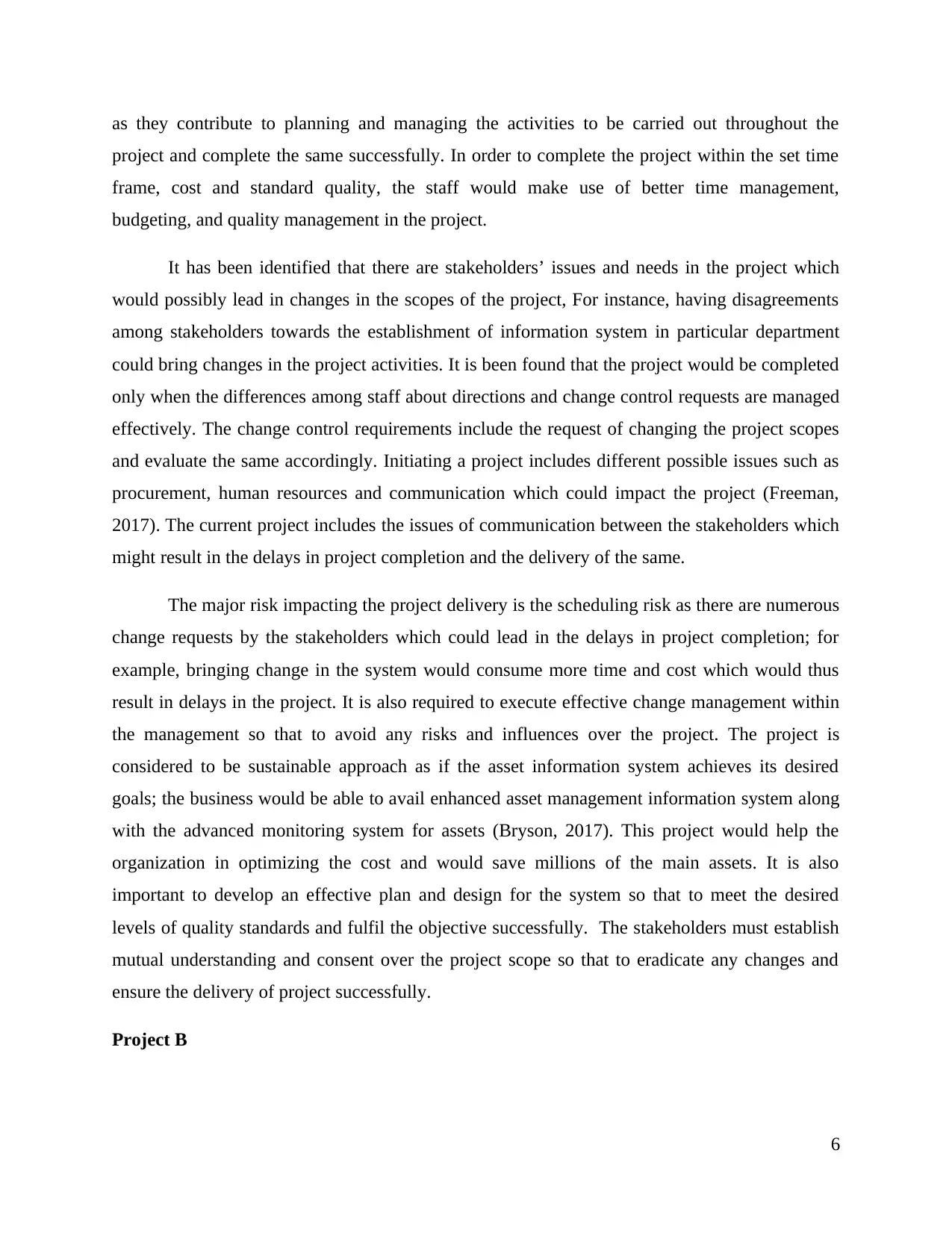
as they contribute to planning and managing the activities to be carried out throughout the
project and complete the same successfully. In order to complete the project within the set time
frame, cost and standard quality, the staff would make use of better time management,
budgeting, and quality management in the project.
It has been identified that there are stakeholders’ issues and needs in the project which
would possibly lead in changes in the scopes of the project, For instance, having disagreements
among stakeholders towards the establishment of information system in particular department
could bring changes in the project activities. It is been found that the project would be completed
only when the differences among staff about directions and change control requests are managed
effectively. The change control requirements include the request of changing the project scopes
and evaluate the same accordingly. Initiating a project includes different possible issues such as
procurement, human resources and communication which could impact the project (Freeman,
2017). The current project includes the issues of communication between the stakeholders which
might result in the delays in project completion and the delivery of the same.
The major risk impacting the project delivery is the scheduling risk as there are numerous
change requests by the stakeholders which could lead in the delays in project completion; for
example, bringing change in the system would consume more time and cost which would thus
result in delays in the project. It is also required to execute effective change management within
the management so that to avoid any risks and influences over the project. The project is
considered to be sustainable approach as if the asset information system achieves its desired
goals; the business would be able to avail enhanced asset management information system along
with the advanced monitoring system for assets (Bryson, 2017). This project would help the
organization in optimizing the cost and would save millions of the main assets. It is also
important to develop an effective plan and design for the system so that to meet the desired
levels of quality standards and fulfil the objective successfully. The stakeholders must establish
mutual understanding and consent over the project scope so that to eradicate any changes and
ensure the delivery of project successfully.
Project B
6
project and complete the same successfully. In order to complete the project within the set time
frame, cost and standard quality, the staff would make use of better time management,
budgeting, and quality management in the project.
It has been identified that there are stakeholders’ issues and needs in the project which
would possibly lead in changes in the scopes of the project, For instance, having disagreements
among stakeholders towards the establishment of information system in particular department
could bring changes in the project activities. It is been found that the project would be completed
only when the differences among staff about directions and change control requests are managed
effectively. The change control requirements include the request of changing the project scopes
and evaluate the same accordingly. Initiating a project includes different possible issues such as
procurement, human resources and communication which could impact the project (Freeman,
2017). The current project includes the issues of communication between the stakeholders which
might result in the delays in project completion and the delivery of the same.
The major risk impacting the project delivery is the scheduling risk as there are numerous
change requests by the stakeholders which could lead in the delays in project completion; for
example, bringing change in the system would consume more time and cost which would thus
result in delays in the project. It is also required to execute effective change management within
the management so that to avoid any risks and influences over the project. The project is
considered to be sustainable approach as if the asset information system achieves its desired
goals; the business would be able to avail enhanced asset management information system along
with the advanced monitoring system for assets (Bryson, 2017). This project would help the
organization in optimizing the cost and would save millions of the main assets. It is also
important to develop an effective plan and design for the system so that to meet the desired
levels of quality standards and fulfil the objective successfully. The stakeholders must establish
mutual understanding and consent over the project scope so that to eradicate any changes and
ensure the delivery of project successfully.
Project B
6
Paraphrase This Document
Need a fresh take? Get an instant paraphrase of this document with our AI Paraphraser
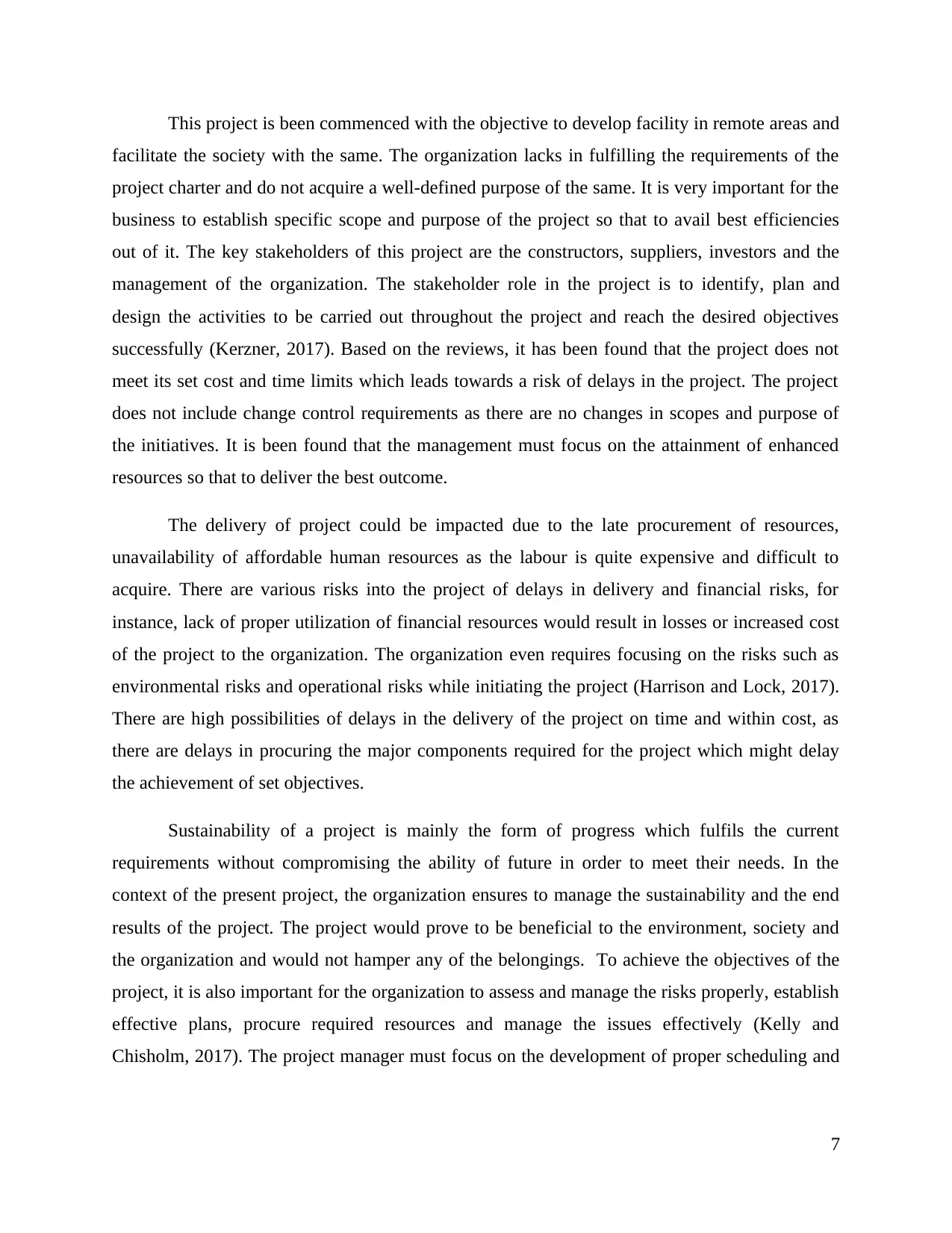
This project is been commenced with the objective to develop facility in remote areas and
facilitate the society with the same. The organization lacks in fulfilling the requirements of the
project charter and do not acquire a well-defined purpose of the same. It is very important for the
business to establish specific scope and purpose of the project so that to avail best efficiencies
out of it. The key stakeholders of this project are the constructors, suppliers, investors and the
management of the organization. The stakeholder role in the project is to identify, plan and
design the activities to be carried out throughout the project and reach the desired objectives
successfully (Kerzner, 2017). Based on the reviews, it has been found that the project does not
meet its set cost and time limits which leads towards a risk of delays in the project. The project
does not include change control requirements as there are no changes in scopes and purpose of
the initiatives. It is been found that the management must focus on the attainment of enhanced
resources so that to deliver the best outcome.
The delivery of project could be impacted due to the late procurement of resources,
unavailability of affordable human resources as the labour is quite expensive and difficult to
acquire. There are various risks into the project of delays in delivery and financial risks, for
instance, lack of proper utilization of financial resources would result in losses or increased cost
of the project to the organization. The organization even requires focusing on the risks such as
environmental risks and operational risks while initiating the project (Harrison and Lock, 2017).
There are high possibilities of delays in the delivery of the project on time and within cost, as
there are delays in procuring the major components required for the project which might delay
the achievement of set objectives.
Sustainability of a project is mainly the form of progress which fulfils the current
requirements without compromising the ability of future in order to meet their needs. In the
context of the present project, the organization ensures to manage the sustainability and the end
results of the project. The project would prove to be beneficial to the environment, society and
the organization and would not hamper any of the belongings. To achieve the objectives of the
project, it is also important for the organization to assess and manage the risks properly, establish
effective plans, procure required resources and manage the issues effectively (Kelly and
Chisholm, 2017). The project manager must focus on the development of proper scheduling and
7
facilitate the society with the same. The organization lacks in fulfilling the requirements of the
project charter and do not acquire a well-defined purpose of the same. It is very important for the
business to establish specific scope and purpose of the project so that to avail best efficiencies
out of it. The key stakeholders of this project are the constructors, suppliers, investors and the
management of the organization. The stakeholder role in the project is to identify, plan and
design the activities to be carried out throughout the project and reach the desired objectives
successfully (Kerzner, 2017). Based on the reviews, it has been found that the project does not
meet its set cost and time limits which leads towards a risk of delays in the project. The project
does not include change control requirements as there are no changes in scopes and purpose of
the initiatives. It is been found that the management must focus on the attainment of enhanced
resources so that to deliver the best outcome.
The delivery of project could be impacted due to the late procurement of resources,
unavailability of affordable human resources as the labour is quite expensive and difficult to
acquire. There are various risks into the project of delays in delivery and financial risks, for
instance, lack of proper utilization of financial resources would result in losses or increased cost
of the project to the organization. The organization even requires focusing on the risks such as
environmental risks and operational risks while initiating the project (Harrison and Lock, 2017).
There are high possibilities of delays in the delivery of the project on time and within cost, as
there are delays in procuring the major components required for the project which might delay
the achievement of set objectives.
Sustainability of a project is mainly the form of progress which fulfils the current
requirements without compromising the ability of future in order to meet their needs. In the
context of the present project, the organization ensures to manage the sustainability and the end
results of the project. The project would prove to be beneficial to the environment, society and
the organization and would not hamper any of the belongings. To achieve the objectives of the
project, it is also important for the organization to assess and manage the risks properly, establish
effective plans, procure required resources and manage the issues effectively (Kelly and
Chisholm, 2017). The project manager must focus on the development of proper scheduling and
7
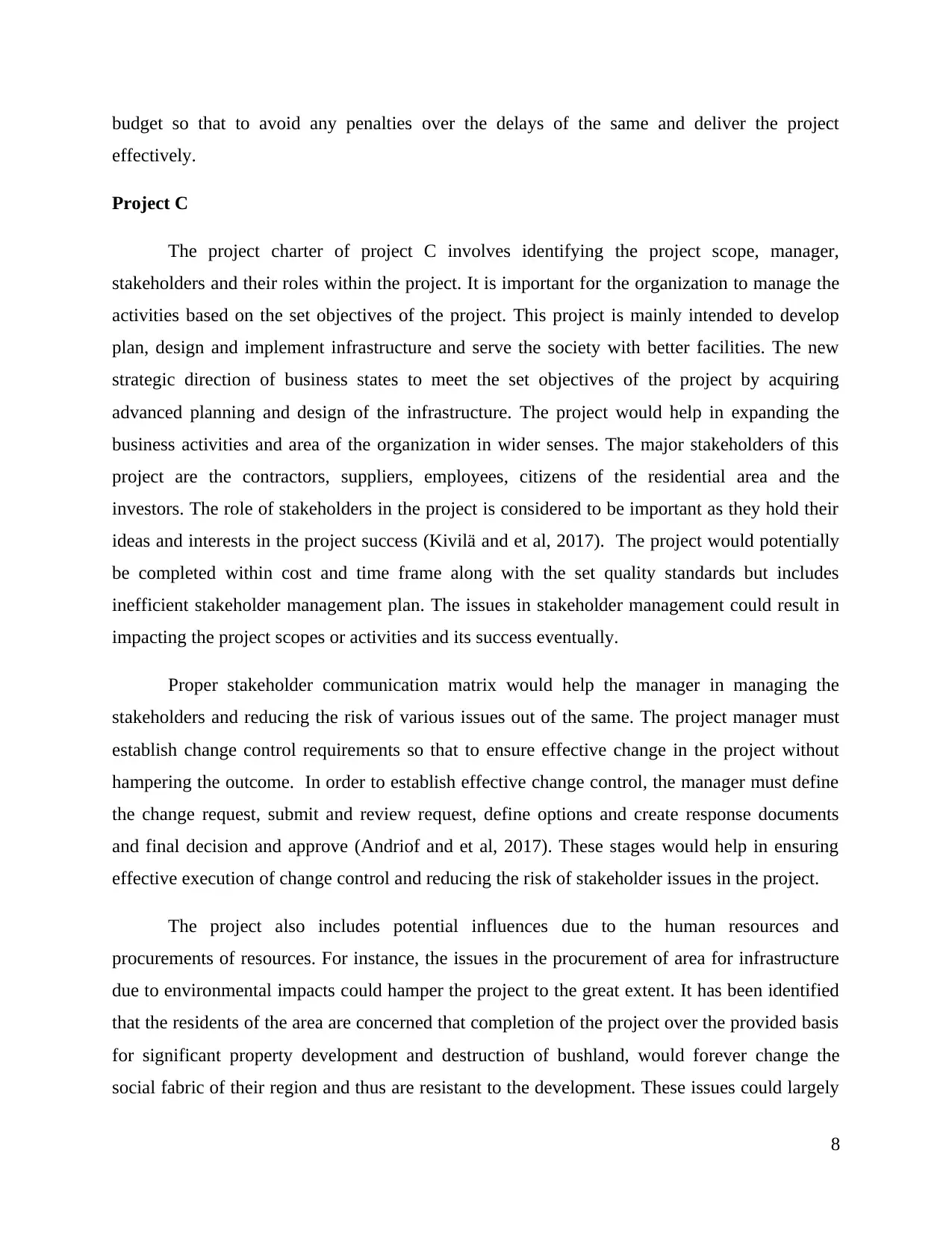
budget so that to avoid any penalties over the delays of the same and deliver the project
effectively.
Project C
The project charter of project C involves identifying the project scope, manager,
stakeholders and their roles within the project. It is important for the organization to manage the
activities based on the set objectives of the project. This project is mainly intended to develop
plan, design and implement infrastructure and serve the society with better facilities. The new
strategic direction of business states to meet the set objectives of the project by acquiring
advanced planning and design of the infrastructure. The project would help in expanding the
business activities and area of the organization in wider senses. The major stakeholders of this
project are the contractors, suppliers, employees, citizens of the residential area and the
investors. The role of stakeholders in the project is considered to be important as they hold their
ideas and interests in the project success (Kivilä and et al, 2017). The project would potentially
be completed within cost and time frame along with the set quality standards but includes
inefficient stakeholder management plan. The issues in stakeholder management could result in
impacting the project scopes or activities and its success eventually.
Proper stakeholder communication matrix would help the manager in managing the
stakeholders and reducing the risk of various issues out of the same. The project manager must
establish change control requirements so that to ensure effective change in the project without
hampering the outcome. In order to establish effective change control, the manager must define
the change request, submit and review request, define options and create response documents
and final decision and approve (Andriof and et al, 2017). These stages would help in ensuring
effective execution of change control and reducing the risk of stakeholder issues in the project.
The project also includes potential influences due to the human resources and
procurements of resources. For instance, the issues in the procurement of area for infrastructure
due to environmental impacts could hamper the project to the great extent. It has been identified
that the residents of the area are concerned that completion of the project over the provided basis
for significant property development and destruction of bushland, would forever change the
social fabric of their region and thus are resistant to the development. These issues could largely
8
effectively.
Project C
The project charter of project C involves identifying the project scope, manager,
stakeholders and their roles within the project. It is important for the organization to manage the
activities based on the set objectives of the project. This project is mainly intended to develop
plan, design and implement infrastructure and serve the society with better facilities. The new
strategic direction of business states to meet the set objectives of the project by acquiring
advanced planning and design of the infrastructure. The project would help in expanding the
business activities and area of the organization in wider senses. The major stakeholders of this
project are the contractors, suppliers, employees, citizens of the residential area and the
investors. The role of stakeholders in the project is considered to be important as they hold their
ideas and interests in the project success (Kivilä and et al, 2017). The project would potentially
be completed within cost and time frame along with the set quality standards but includes
inefficient stakeholder management plan. The issues in stakeholder management could result in
impacting the project scopes or activities and its success eventually.
Proper stakeholder communication matrix would help the manager in managing the
stakeholders and reducing the risk of various issues out of the same. The project manager must
establish change control requirements so that to ensure effective change in the project without
hampering the outcome. In order to establish effective change control, the manager must define
the change request, submit and review request, define options and create response documents
and final decision and approve (Andriof and et al, 2017). These stages would help in ensuring
effective execution of change control and reducing the risk of stakeholder issues in the project.
The project also includes potential influences due to the human resources and
procurements of resources. For instance, the issues in the procurement of area for infrastructure
due to environmental impacts could hamper the project to the great extent. It has been identified
that the residents of the area are concerned that completion of the project over the provided basis
for significant property development and destruction of bushland, would forever change the
social fabric of their region and thus are resistant to the development. These issues could largely
8
⊘ This is a preview!⊘
Do you want full access?
Subscribe today to unlock all pages.

Trusted by 1+ million students worldwide
1 out of 30
Related Documents
Your All-in-One AI-Powered Toolkit for Academic Success.
+13062052269
info@desklib.com
Available 24*7 on WhatsApp / Email
![[object Object]](/_next/static/media/star-bottom.7253800d.svg)
Unlock your academic potential
Copyright © 2020–2025 A2Z Services. All Rights Reserved. Developed and managed by ZUCOL.




